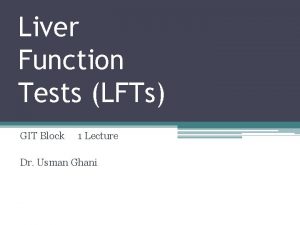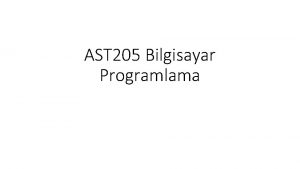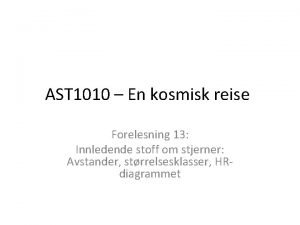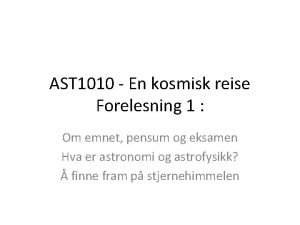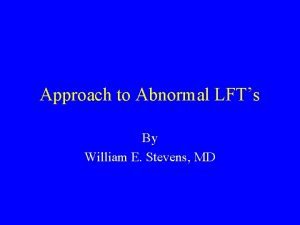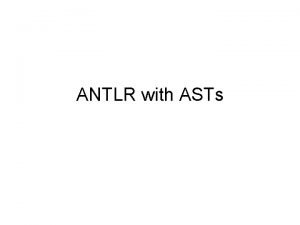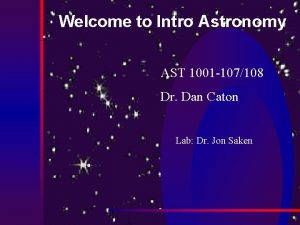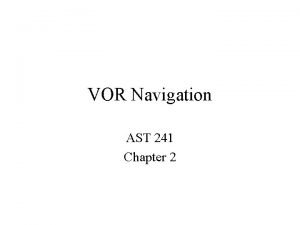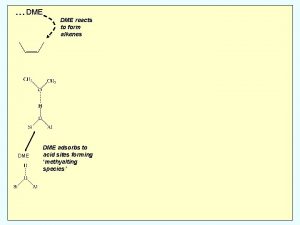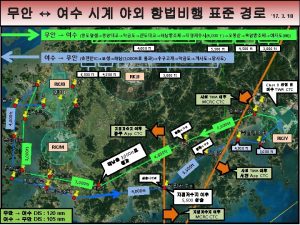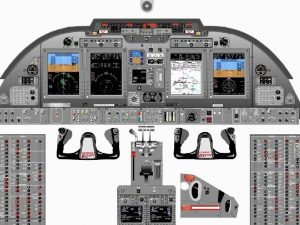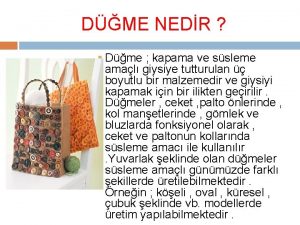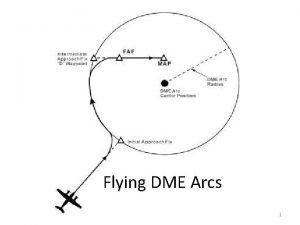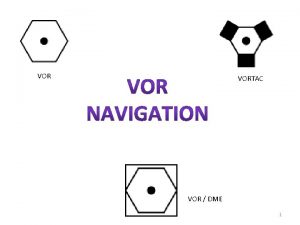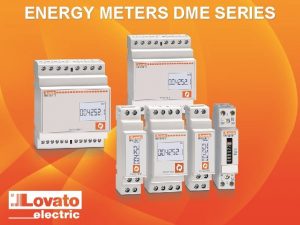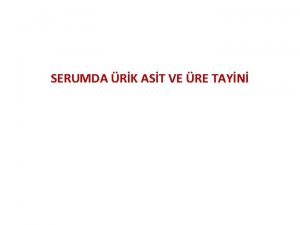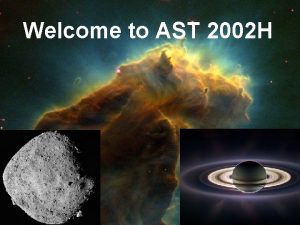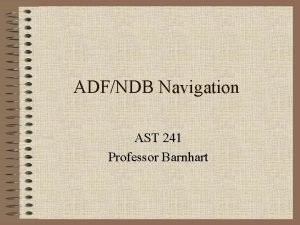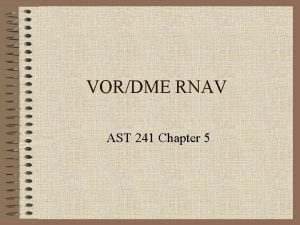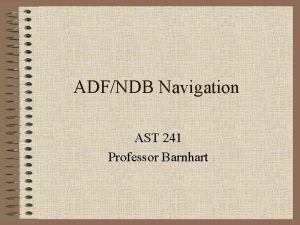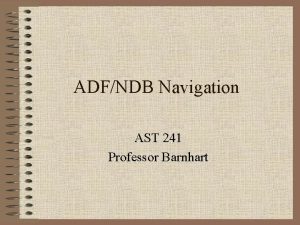DME AST 241 DME Theory Most VORs in




















- Slides: 20

DME AST 241

DME Theory • Most VOR’s in the US have DMEdistance measuring equipment or are colocated with a military TACAN facility which provides the same information. • VOR navigation is much improved with DME as it only provides: • Azimuth information

DME Theory • DME is required for aerial navigation above? • FL 240 or 24, 000 ft. • Especially useful in IFR operations • VOR and DME are essentially unified systems which are seamless to the pilot when co-located

DME theory • Each VOR frequency from 108. 00 to 117. 95 MHz (VHF) has a corresponding UHF freq. Ranging from 962 – 1213 MHz • Pilots usually have to tune only one freq. With newer receivers • DME’s can be received independent of the VOR if the tuner is separate but the information is of little use for most pilots

DME Theory • For civilian users VOR/DME and VOR’s co-located with TACAN (VORTAC’s) are essentially the same thing providing pilots with the same information. • TACAN was developed by the military to: – Rectify terrain interference problems – Rectify portability problems – Rectify the need for a level platform- (carriers)

DME Theory • Civilian users can’t take advantage of TACAN’s azimuth information and military pilots can’t use DME information

DME Operation • Similar to the ATC Radio beacon system or Transponder system • VOR’s are a Passive System giving continuous information • DME’s respond only when interrogated making them an Active System

DME Operation • Each DME receiver emits two distinctly (to that receiver) spaced pulses which are replied to in identical fashion by the ground based unit. • The DME receiver ignores all other replies. • This is why the DME can take up to 10 seconds to “lock on” to its unique reply • Once locked it updates every 1/10 th mile

DME Operation • The time difference between interrogation and reply corresponds to the aircraft’s straight line distance from the station. • 12/1, 000 of a second in time corresponds to 1 NM in distance

DME Operation • DME accuracy varies from 3 % of total distance (6 NM at 200 miles out) up to being within. 1 NM at all distances for the higher end receiversas good as GPS • The most common operational mistake is to forget to select the correct VOR if the aircraft is equipped with 2 VOR’s or leaving it in the “hold” mode which holds the last frequency tuned rather than the current one.

DME operation • The most common units today are selectable between the dual VOR receiversif not then the DME signal is usually taken from the #1 VOR but BE SURE! • ALWAYS VERIFY!!

DME Operation • Groundspeed and time to Station- Since DME uses rate of response information to get distance it is a small step for the receiver to calculate groundspeed and time to the station. • This information is usually displayed in a separate window labeled- KTS. MIN. OFF

DME Operation • It is important to remember that this only works if heading directly to or from the station- angular motion w. r. t. the station makes all DME information USELESS!

DME identification • DME stations are identified in the same coded manner using the same identification as the corresponding VOR station. • The DME portion is broadcast at a higher pitch and is less frequent than the VOR identification- every 30 seconds.

DME overload • DME transmitters can become overloaded during heavy usage causing the “late comers” not to lock on the freq. • It is courteous to always turn off the DME receiver when not in use such as when on the ground or when DME info. Is not needed.

DME error • Slant range error occurs because the DME calculates its straight line or “slant range” distance from the station which is not as useful to pilots as ground distance. • This causes all DME indications to be inaccurate when greater than 1, 000 ft. AGL for each NM from the station- otherwise it can be ignored.

DME Error • For example if a pilot is at 3, 000 ft AGL at 2 miles from the station the error is out of tolerance. • Remember for accuracy be at least 1 NM from the station for each 1, 000 ft AGL

DME Arc • Older instrument approach procedure where the DME information is used to fly a constant radius around the transmitter • This becomes easier when VOR “lead radials” are used to prompt the turn

DME Operation • • • DME is Rho-Rho navigation Rho = distance Theta = azimuth VOR/DME together is theta – rho nav. 2 VOR’s are theta - theta nav. Rho – rho nav. Requires 3 DME readings to determine position

Questions? The End
 Ast levels and exercise
Ast levels and exercise Mississippi classification of hellp syndrome
Mississippi classification of hellp syndrome Alt and ast normal range
Alt and ast normal range Hepatic function panel
Hepatic function panel Ast more than alt
Ast more than alt Hepatomegaly ultrasound
Hepatomegaly ultrasound Thyroxine binding prealbumin
Thyroxine binding prealbumin Ast 205
Ast 205 Ast 1010
Ast 1010 Ast1010 eksamen
Ast1010 eksamen Cholestatic pattern
Cholestatic pattern Antlr tree walker
Antlr tree walker Potitur
Potitur Half life of ast
Half life of ast High ast
High ast Amy ast ohio
Amy ast ohio High ast
High ast Ast 1001
Ast 1001 Metreküp desimetreküp kaç katına eşittir
Metreküp desimetreküp kaç katına eşittir Ast code of ethics
Ast code of ethics Metrenin ast ve üst katları
Metrenin ast ve üst katları


